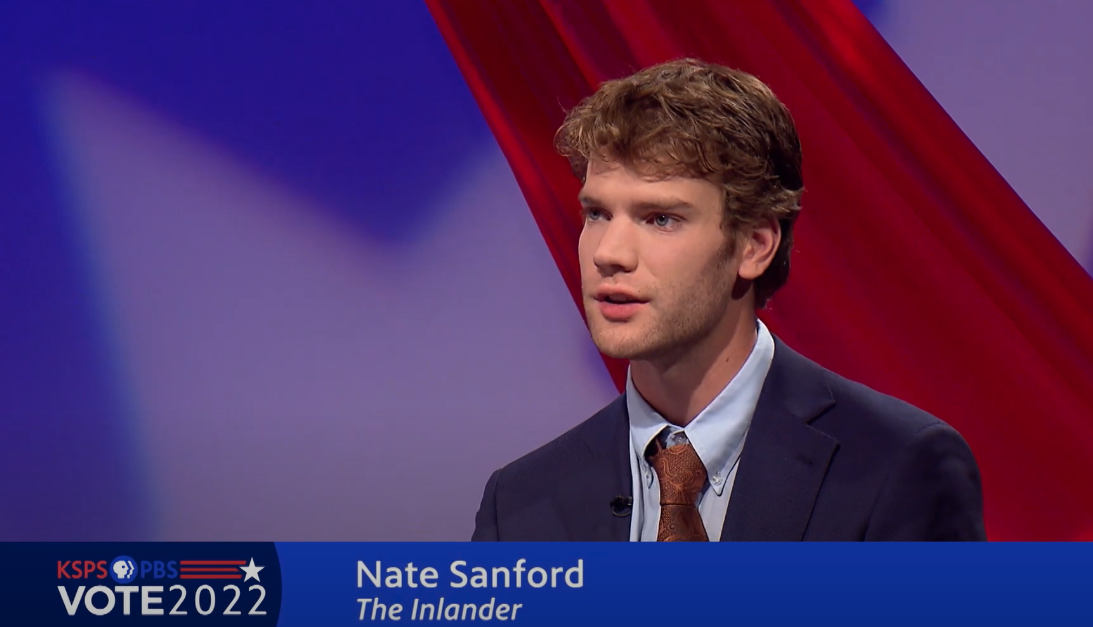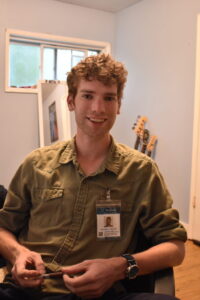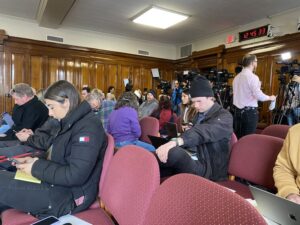Nate Sanford knows how to make an impression

Alumni who captained team credited for 'The Front' rebrand is still making waves inland
By Madisun Tobisch
If you’ve been involved with Western Washington University’s journalism department at all in the last three years, you’ve probably heard the name Nate Sanford.
Whether it be for his coverage of lead in Western’s drinking water as a JOUR 307 student or for his consecutive two-quarter title as editor-in-chief during The Front’s rebrand, Sanford’s reputation has not faded.
“If you’re passionate about something, I think it’s important to really put everything into it,” Sanford said.

Right after graduating in spring 2022, he was hired on as a staff writer for The Inlander, where he spent his internship the summer before. Now in Spokane, his coverage has focused on in-depth pieces written on a week-long timeline. Some stories at The Inlander are in the works for multiple months, which Sanford said gives his work the opportunity to achieve depth and consider angles that fast-paced coverage can miss.
Assistant Professor Betsy O’Donovan, who first met Sanford while he was taking her newswriting class, said she’s seen a recent era of students who are pushing themselves early on to find not just any form of work, but work that is meaningful to them.
“I didn’t know what I was going to do after I graduated, so, no hate, but I think for students who have that clarity, there’s a lot you can do in our program, so that you are really ready to go and you have a bit of a reputation already before you graduate,” she said.
Sanford credits his own fast and painless job search to a mixture of luck, good timing and dedication. He said his freelance work with publications like Crosscut helped increase his value as a potential hire before he had finished out his classes.
Always one to see the bigger picture, Sanford recognized the current climate was the perfect opportunity to push for the creation of a consistent brand. Because of COVID-19, printing was halted and social media presence for The Front had taken a hit, but the community’s need for information was at an all time high.
“It felt like it was both a really discouraging time to go into journalism, but also a really exciting time, because everything was just up in the air and kind of crazy,” Sanford said.
One of his biggest moves during his time in the department was facilitating the rebrand of The Front. Formally a print publication with a different name and look, Sanford and his spring 2021 staff of editors were the ones to carefully compile years of research and planning across numerous staffs and make the leap into a new era.
A new website, branding style guide, newsletter and logo were realized out of Sanford’s leadership and have remained consistent for the last two years.
O’Donovan was able to see Sanford’s work evolve as she advised The Front from fall 2019 to summer 2021 before passing the role onto current advisor Kie Relyea.
“The pandemic was, and is, in a lot of senses one of the worst things that’s happened, I think, in most of our lifetimes, but I will say for the culture of The Front, it accelerated a lot of things,” she said.
Sanford’s fervor hasn’t slowed — quite the opposite. However, he doesn’t miss the additional barriers that come with the role of student journalist.
“It’s really cool being able to focus and go really in depth into one thing every week, and also being able to shut it off and not have to worry about homework when you get home from work, which is nice,” he said.
Last fall, Sanford woke up to a message from none other than the New York Times.
It was early in the media blitz surrounding the Moscow, Idaho community, which was left reeling after the murders of four University of Idaho students.
The message said he had two hours to make the hour-and-a-half trip over to Moscow to represent the nation’s biggest news platform at a press conference. A colleague, who was not available for the assignment, suggested the NYT editor contact Sanford. His work later contributed to their coverage of the murders.
“I literally had just woken up when I got the text and was very tired and confused, and had other plans that day — but frankly, when the New York Times calls – ‘yeah, whatever [it is]. I’ll do it,'” he said.

Sanford ended up spending the night in Moscow. He said his experience with seeing the NYT operate was eye-opening and the quick turnaround from reporting to publishing not only heightened the experience, but also added to the pressure.
“There’s the moment when you realize, ‘oh shoot, the print deadline for the New York Times,’ … just a little intimidating,” Sanford said.
With the NYT and his own coverage for The Inlander regarding the Moscow murders, Sanford got the rare experience of covering a national media sensation within his first year as a professional reporter.
He said the coverage of the murders has been excessive at times but still a valuable learning experience as he tries to find an angle among a community that’s burnt out on the media presence.
“I think people are kind of drawn to and fascinated by stuff like that, but it can be a bit of voyeuristic at times, and so I’ve tried to focus on what’s not being covered,” he said.
In his most recent coverage, Sanford uncovered “behind the curtain” activity between Spokeane’s police department and a council of business and commercial property owners looking for specific crime and homelessness-related data to lobby city council members with. His investigation uncovered hundreds of emails, many of which detail sensitive police department information.
It goes to show Sanford continues to build on his reputation through his dedication to journalism. His contribution as a student in the journalism department is only one feat on his ever-growing resume.
O’Donovan looked back on her time with Sanford as her student fondly, saying, from very early on, he possessed all the qualities you would want to see in any journalism student. Still, she recognized his true gift to the industry isn’t his natural talent.
“Nate isn’t doing magic,” she said. “He’s not doing something that other people aren’t capable of. What Nate is doing that is really significant and powerful is he’s showing other people it can be done.”
